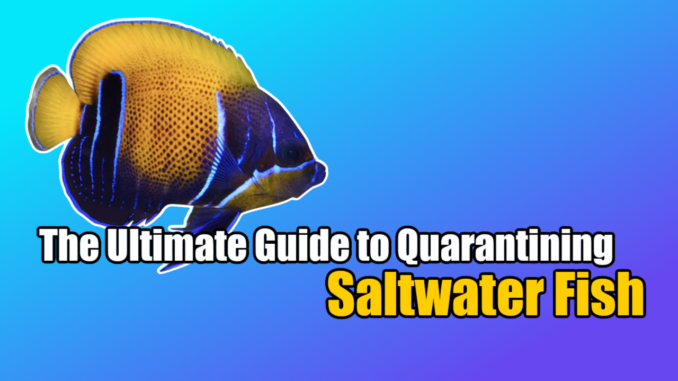
Introduction
Quarantining saltwater fish is one of the most critical steps in maintaining a healthy, disease-free reef tank. Yet, many aquarists overlook or rush through this process, leading to catastrophic losses. This book provides an in-depth guide on why quarantine is essential, how to set up a proper quarantine system, and how to treat common diseases effectively. By following the practices outlined in this book, you will significantly increase the chances of long-term success in the saltwater aquarium hobby.
Why Quarantine?
The primary goal of quarantine is to prevent the introduction of diseases, parasites, and pests into your main display tank. Fish that appear healthy may still carry pathogens that can wipe out an entire aquarium. Beyond disease prevention, quarantine also helps fish adjust to captivity, recover from stress, and establish strong eating habits before entering the main tank.
Benefits of Quarantine:
- Prevents Disease Outbreaks: Many common saltwater diseases, such as Marine Ich (Cryptocaryon irritans) and Velvet (Amyloodinium ocellatum), are difficult to treat in a fully stocked reef tank. Quarantine ensures that new arrivals are free from these diseases before introduction.
- Reduces Stress on Fish: The transition from the ocean or breeder facilities to an aquarium is stressful. Quarantine provides a controlled environment where fish can recover without the competition and aggression found in a display tank.
- Allows for Proper Observation: Some diseases and parasites take time to manifest. A dedicated quarantine period allows aquarists to spot early signs of illness and treat them before they spread.
- Improves Feeding Habits: Many fish are reluctant to eat in a new environment. Quarantine provides a stress-free setting where they can be weaned onto an appropriate diet.
How Long Should You Quarantine?
A 4-6 week quarantine period is standard, though some aquarists prefer an even longer duration for higher-risk species. This time allows for careful observation and ensures that diseases like Marine Ich and Velvet do not appear before introducing the fish into the main system.
Factors Affecting Quarantine Duration:
- Species Sensitivity: Some fish, such as tangs and angelfish, are more prone to parasites and may require extended quarantine.
- Source of the Fish: Wild-caught fish often harbor more pathogens than captive-bred specimens and may need longer quarantine and treatment.
- Visible Symptoms: If a fish develops a disease during quarantine, the countdown resets after successful treatment and observation.
For aquarists using prophylactic treatments, the full duration of medication courses should be completed before releasing the fish.
Setting Up a Proper Quarantine Tank
A quarantine tank should be designed for easy maintenance and effective disease control. Here are the essential components:
Essential Equipment:
- Tank Size: 10-40 gallons depending on the size and number of fish being quarantined.
- Bare-Bottom Setup: No sand or rock to make cleaning and treatment easier.
- Filtration: Sponge filter that has been seeded in a cycled tank.
- Aeration & Heating: Ensure stable oxygen levels and proper temperature.
- Hiding Spots: PVC pipes or plastic decorations to reduce stress.
- Lighting: Dim lighting to reduce fish stress and make disease symptoms easier to spot.
Ideal Water Parameters:
- Temperature: 76-78°F
- Salinity: 1.018-1.025 SG
- pH: 8.0-8.4
- Ammonia & Nitrite: 0 ppm
- Nitrate: Below 10 ppm
Regular water changes and the use of ammonia-removing media are critical for maintaining water quality.
Medication & Copper Treatment Monitoring
If you are treating with copper-based medications such as Copper Power or Cupramine, using an accurate test kit is critical. Copper levels must be maintained within the therapeutic range—too much can be toxic, while too little is ineffective.
Best Practices for Copper Treatment:
- Use Test Kits: Hanna or Seachem test kits provide accurate readings.
- Monitor Fish Health: Watch for signs of copper toxicity, such as erratic swimming, heavy breathing, or loss of appetite.
- Gradual Introduction: Introduce copper gradually over 48 hours to avoid shocking the fish.
Observation vs. Prophylactic Treatment
There are two primary approaches to quarantine:
- Observation Method: The fish is monitored for signs of illness, and treatment is only applied if symptoms appear.
- Prophylactic Treatment: The fish is treated with medications preemptively, even if no symptoms are visible.
Pros and Cons:
| Approach | Pros | Cons |
|---|---|---|
| Observation | Avoids unnecessary medication, less stressful for fish | May allow undetected diseases to develop |
| Prophylactic Treatment | Catches potential illnesses early, prevents asymptomatic carriers | Some fish may react poorly to medications |
Identifying and Treating Common Diseases
Common Diseases and Treatments:
- Ich & Velvet: Copper-based medications like Copper Power or Cupramine.
- Flukes & Internal Parasites: Treated with PraziPro.
- Bacterial Infections: Broad-spectrum antibiotics such as Kanaplex, Metroplex, or Furan-2.
- Fungal Infections: Antifungal treatments and improved water quality.
Avoiding Cross-Contamination
Cross-contamination between the quarantine and display tanks is a major risk. Follow these best practices:
- Use dedicated equipment (nets, siphons, and tools) for each tank.
- Wash hands thoroughly after handling quarantine fish.
- Never transfer water from the quarantine tank into the display tank.
Maintaining Water Quality in Quarantine
Water quality can decline quickly in a small quarantine system. Frequent water changes and proper monitoring are crucial:
- Ammonia & Nitrite Control: Use an ammonia alert badge and perform water changes as needed.
- Filtration: A pre-seeded sponge filter helps maintain biological filtration.
- Monitoring Parameters: Keep ammonia and nitrites at zero, and maintain stable pH and temperature.
Nutrition & Stress Management
Proper nutrition and stress reduction techniques help fish adjust more quickly:
- Offer a varied diet including frozen, live, and pellet foods.
- Use garlic-based foods or additives to stimulate appetite.
- Keep lighting dim and avoid excessive movement near the tank.
Quarantine is Essential—Even for Trusted Sources
Many aquarists skip quarantine if they buy from “trusted” sources. However, even healthy-looking fish can be asymptomatic carriers of parasites and disease. Always quarantine every new fish, regardless of the source.
Location & Aerosolized Contamination
Quarantine tanks should be kept in a separate area from the display tank to minimize airborne transmission of disease. Diseases like Marine Velvet and Ich can become aerosolized in water droplets, increasing the risk of infection if tanks are too close together.
The Impact of Water Conditioners on Copper Treatment
Water conditioners like Seachem Prime, Amquel, and other ammonia detoxifiers can neutralize copper medications, making them ineffective. If using copper, avoid adding these products to the quarantine tank.
Conclusion
Quarantining saltwater fish is essential for preventing disease outbreaks, improving survival rates, and maintaining a thriving reef aquarium. While it requires extra effort, the benefits far outweigh the risks.




